The cost saving potential of back office outsourcing

Key highlights
- The global back office outsourcing market, also known as business process outsourcing (BPO), is projected to grow by more than a quarter of its current size over the next five years.
- To appreciate the full range of cost saving possibilities from outsourcing, direct and indirect costs need to be considered independently.
- Direct costs are generally easy to trace and assign to a specific business function or department, and savings are mostly derived from lower personnel expenditure on hiring, wages, and benefits.
- Indirect costs tend to be spread out across multiple business functions, and outsourcing one particular department can lead to lower costs for many other ones within a business.
The market for back office outsourcing
In a competitive global business landscape, made all the more difficult due to an economic downturn in most major economies, strategies to streamline operations and maximise efficiency become more relevant. In this context, the particular business strategy of back office outsourcing will garner renewed attention. By entrusting either core or non-core, but non-client facing, business functions to specialised service providers, typically in an offshore location, companies can focus on more strategic activities while achieving cost savings and improved productivity.
The business process outsourcing (BPO) market, the formal definition for what is more casually called back office outsourcing, has reached sizeable proportions with strong growth prospects. According to the data aggregation platform Statista, the industry size in 2023 will be worth US$ 350 billion. It is estimated that the BPO market will witness a compound annual growth rate (CAGR) of 6.5% during 2023-27, reaching an estimated value of USD 450 billion by the end of the forecast period. These projections underscore the industry’s significant growth potential and increasing recognition of its benefits by clients.
Companies commonly outsource a range of back office functions. They generally include finance and accounting, human resources (HR), payroll administration, data entry, customer support, IT support, software development, and supply chain management. By delegating these tasks to external third parties, businesses can tap into specialised knowledge and technology, allowing them to operate more efficiently.
The adoption of back office outsourcing varies among companies depending on their industry, size, and operational requirements. However, numerous studies indicate that a significant proportion of organisations across the globe have embraced this practice. According to a 2022 survey by Deloitte, a consulting firm, 52% of executives outsourced one or more business functions, while 76% reported outsourcing an IT function. These findings highlight the widespread adoption of back office outsourcing as a strategic business decision.
Lowering direct costs
While there are a variety of reasons for companies to outsource, cost reduction remains a key priority. This is a big reason for back office outsourcing being a thriving industry, as it saves clients significant direct costs, from day one. Of course, the specific category of costs reduced, and by how much, depends heavily on which function or functions are being outsourced.
Most of the direct cost savings in outsourcing are derived from lower spending on different aspects of human resources utilised by a company. These are up front, easy-to-identify costs that are typically linked to the specific department or function being outsourced.
Hiring
This is the most obvious cost that any type of outsourcing can reduce, both in terms of actual expenditure incurred and time saved. In 2022, the Society for Human Resource Management (SHRM), the world’s largest association devoted to HR management, estimated that the average cost per hire was almost US$ 4,700. The cost per hire can very for different roles, of course, and is typically higher than the average for IT and software development roles.
In addition to the direct outlay of recruitment costs, the overall cost turns out to be much higher, when the total time taken to hire is factored in. In fact, the SHRM estimates that the total cost to hire a new employee can be up to three to four times the position’s salary. A big part of the reason is the time it takes to hire new employees; a SHRM survey estimate from 2015 revealed the average time required to fill an open position to be 42 days. This means that not only those in the HR department, but other departmental managers also have to invest time in the hiring process, taking time away from core organisational activities.
The table below shows the average time to hire globally and in North America by different functions. It gives a sense of how this varies by job role, but also shows that for most it takes about a month, while keeping in mind that these are averages and in many cases it takes longer to fill the role. By working with an outsourcing provider, client companies can not only save a significant chunk of direct recruitment costs, but also time, which can be redirected towards other business functions.
Average Hiring Time: Global and North America
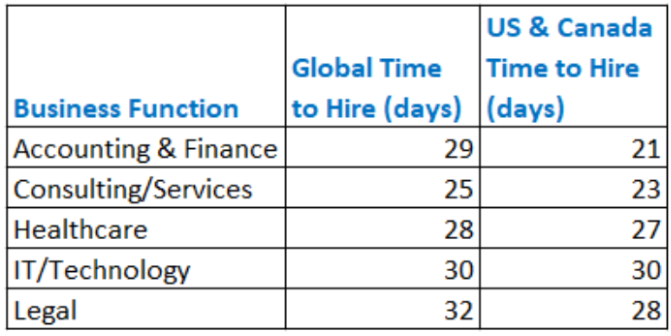
Wages
Another reason that back office outsourcing has become an effective strategy for companies to cut costs is the availability of skilled professionals in other countries with lower salaries. By leveraging this global talent pool, businesses can reduce their expenses while maintaining, or even improving, the quality of work.
For instance, companies in industries ranging from banks to insurance firms have for decades been outsourcing customer support functions to countries like India and the Philippines, where skilled professionals provide excellent service at a fraction of the cost compared to their counterparts in Western countries. Similarly, much software development is actually done in Eastern European and South Asian countries, where highly qualified software engineers offer their services at comparatively lower rates. Additionally, administrative tasks such as data entry, transcription, and bookkeeping can be efficiently handled by an outsourcing partner based in a country with lower labour costs.
The differential in professional salaries is captured well by the software development function, with perhaps the highest demand in recent years. The table below shows a comparison of average salaries of software developers in 2023 from five advanced economies, with five others that are current or potential future outsourcing hubs. The average salary in the five hub countries is less than one-fifth that in the advanced economies, demonstrating the large differential and potential for savings, without compromising on professionalism.
Software Engineer Average Salary Comparison, 2023
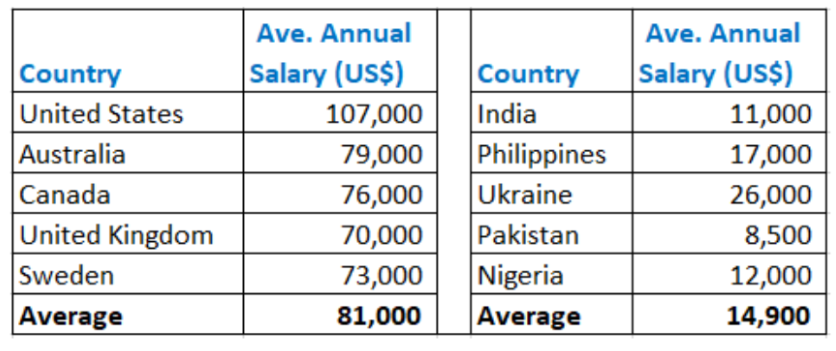
Benefits
Wages or salaries comprise only one part of an employee’s total compensation cost for a company. In almost all Western economies, various employment benefits add up to comprise an additional and significant cost item. By outsourcing back office or other functions, this cost can also be brought down in a major way. This is because like salaries, benefits packages are also correspondingly lower in typical offshore locations.
To get a sense of how much employment benefits can actually cost companies, we analysed recent data from the US Bureau of Labor Statistics (BLS). According to information compiled by the BLS in December 2022, in the private sector, the total compensation cost per employee averaged US$ 40.23 per hour worked. Within this, wage and salary costs averaged $28.37 and accounted for 70.5% of the total compensation cost, while benefit costs were $11.86, representing 29.5% of the total. Benefit costs are typically comprised of paid leave, supplemental pay such as overtime, insurance, retirement contributions, and legally mandated payments, depending on the country.
US Employee Salary to Benefits Ratio, Dec 2022
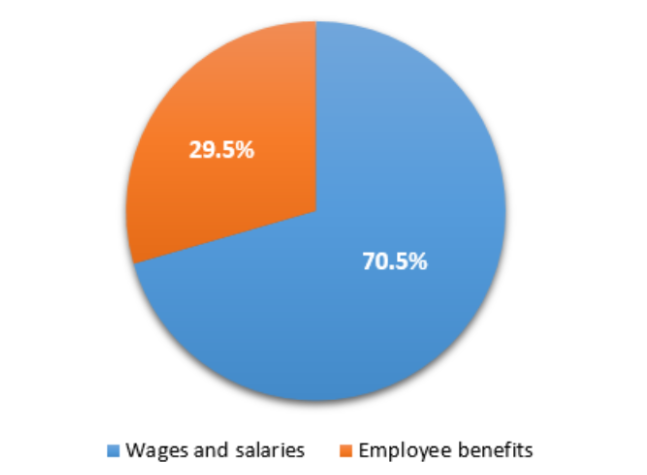
What this means is that, in the US for example, on average the total employment cost of an employee turns out to be about 40% higher than the person’s salary! Let’s apply this to the software development industry, where according to the table presented earlier, the average employee’s salary is about US$ 107,000. However, the average software engineer actually costs about US$ 153,000, after factoring in the additional benefits cost.
Now, although benefits in offshore locations are unlikely to have a similar ratio to salary as they do in offshore locations, but even using the 40% figure, it can be estimated that the total employment cost for a software developer in the most ‘expensive’ offshore country of China, will only be around US$ 34,000. This would save a company 80% in total employment costs alone, if it were to outsource its software development function in some form.
How indirect costs are reduced
So far, we have discussed the more obvious and direct cost savings that can be achieved through back office outsourcing, or outsourcing more generally. These are relatively simple to isolate, as they are usually related to a single business category or function, such as employee salaries.
Companies can drive further efficiency gains by correctly identifying indirect costs, that can also be reduced as a result of outsourcing. In general, indirect costs are defined as costs that represent the expense of doing business not readily identified with a particular project or activity, but are necessary for the general operation of the company. These can be either fixed or variable, located in departments other than the one where the activity is performed, and typically include (though are not limited to) overhead costs, capital costs, and personnel-related costs.
While there are few scientific studies available to assess how indirect costs are reduced through outsourcing, partly due to the difficulty of accurately allocating them within an organisation, our literature review shows that this is indeed the case. For instance, a seminal MIT study based on data from approximately 300 U.S. companies over the 1999-2003 period, estimated that a US$ 96 million increase in IT outsourcing spending by a company was associated with, on average, a US$ 121 million drop in operating costs in other, non-IT functions.
Before going into a case study of how to incorporate and estimate indirect cost savings from outsourcing a business function, it’s important to understand the main areas in which they accrue and why. According to a white paper by a facilities management firm, 75% of indirect savings are likely to be realised in the human resources, finance, and procurement functions. Nevertheless, depending on which functions are actually outsourced and how, most other departments in a company can experience lower indirect costs.
The table below covers most back office and strategic functions at an organisation, and the relevant tasks performed within them, that are likely to experience indirect cost savings by outsourcing facilities management. As the cost items in each department show, outsourcing any function – front or back office – would result in reduced indirect costs across most of these departments. For instance, if sales or software development were outsourced instead of facilities management, a company would still experience cost savings in the corporate real estate department through lower rental or lease expenses due to the need for a smaller office space.
Sample Indirect Costs: Facilities Management
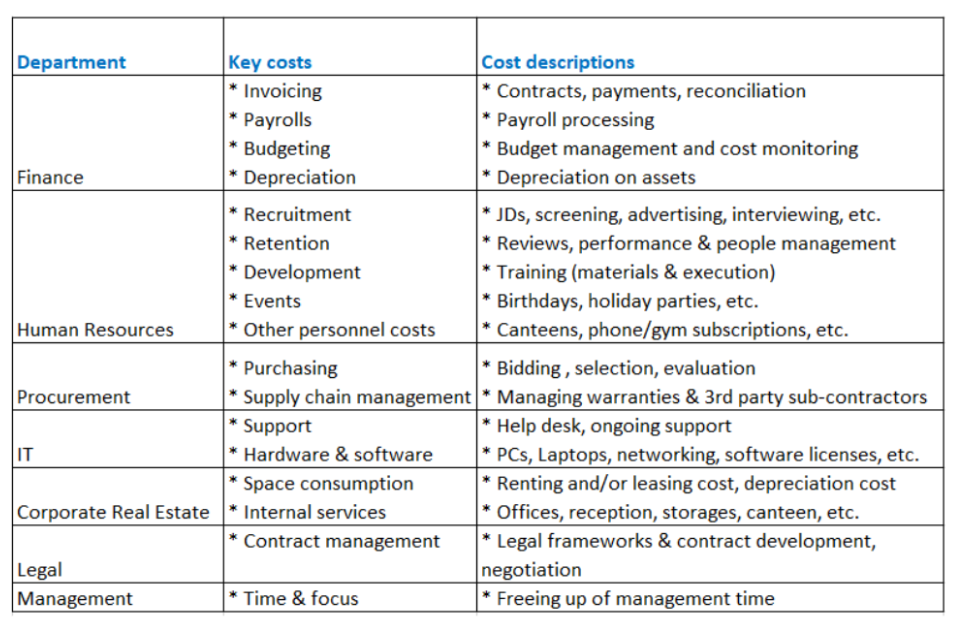
Calculating overall cost savings
To round off, we will summarise a case study to demonstrate how to accurately estimate the potential overall cost savings from outsourcing a business function. Once again, this example applies to a company that outsourced its facilities management function, but the framework would apply the same way if any other function were being considered.
The major steps involved in evaluating any outsourcing proposal are as follows:
- Pre-outsourcing: The total annual cost of running the department, disaggregated by direct and indirect costs.
- The total annual cost savings expected to be realised, disaggregated by direct and indirect costs.
- Post-outsourcing: The total annual cost of running the department, disaggregated by direct and indirect costs.
We will consider the example of a Scandinavian industrial manufacturing company that decided to outsource its entire facilities management operation. In the pre-outsourcing phase, the cost break up was as follows:
- Direct costs: US$ 32 million
- Indirect costs: US$ 2.1 million
The company estimated that US$ 5.8 million would be saved in direct costs through the outsourcing operation, while US$ 1.37 million would be saved in indirect costs. Accordingly, the cost structure post-outsourcing looked as follows:
- Direct costs: US$ 26.2 million
- Indirect costs: US$ 0.73 million
Overall, the exercise would lower the company’s total costs by 21% by outsourcing its facilities management function.
An interesting point to note here is that, as opposed to direct cost savings, the indirect cost savings were spread out over multiple departments other than facilities management. This is because managing facilities internally required time and expense from other functions, some of which could be lowered or elimated through outsourcing.
The table below shows how these calculations were made in the case of this company. These estimates will of course differ for every company, depending on specific internal costing assumptions and which function is being outsourced. Nevertheless, it demonstrates a framework that can be used by any firm to assess its potential indirect cost savings.
Case Study: Sample Indirect Cost Reduction Exercise
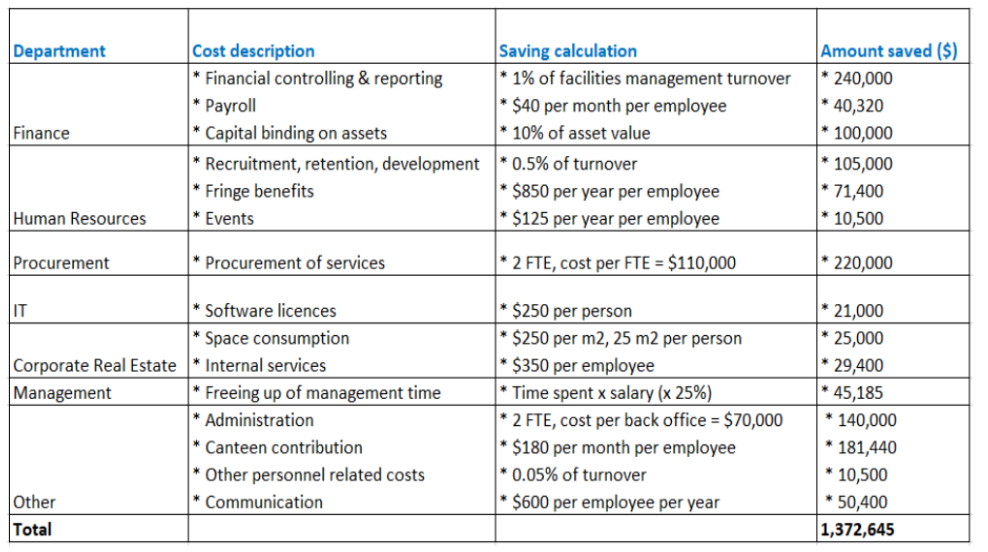
A last point is about how much indirect savings are possible for companies through outsourcing. While in theory, it should be possible to realise 100% of all the potential indirect savings, practically this is unlikely to be possible in any situation. In this example, the company was able to save 65% of indirect cots. Although this is a specific case, and cannot be readily extrapolated to other situations, we estimate that indirect cost savings of around 50% can usually be realised.
Final takeaway
The overarching imperative for a company considering outsourcing a business function or department should be to treat direct and indirect costs differently. As our analysis emphasises, the latter tend to be more complex to estimate, but can potentially unlock non-obvious savings and efficiencies. Finally, to make any outsourcing effort successful, a company needs to invest some time and resources during the evaluation and planning stages to correctly assess the potential benefits. It will also need to devote some resources to create a system to monitor the outsourced operations, which should be viewed as an investment necessary to maximise their potential.









